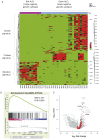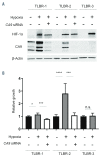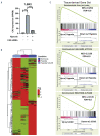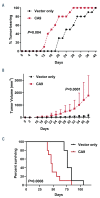Molecular profiling reveals a hypoxia signature in breast implant-associated anaplastic large cell lymphoma
- PMID: 32414854
- PMCID: PMC8168507
- DOI: 10.3324/haematol.2019.245860
Molecular profiling reveals a hypoxia signature in breast implant-associated anaplastic large cell lymphoma
Abstract
Breast implant-associated anaplastic large cell lymphoma (BIA-ALCL) is a recently characterized T-cell malignancy that has raised significant patient safety concerns and led to worldwide impact on the implants used and clinical management of patients undergoing reconstructive or cosmetic breast surgery. Molecular signatures distinguishing BIA-ALCL from other ALCLs have not been fully elucidated and classification of BIA-ALCL as a WHO entity remains provisional. We performed RNA sequencing and gene set enrichment analysis comparing BIA-ALCLs to non-BIA-ALCLs and identified dramatic upregulation of hypoxia signaling genes including the hypoxia-associated biomarker CA9 (carbonic anyhydrase-9). Immunohistochemistry validated CA9 expression in all BIA-ALCLs, with only minimal expression in non-BIA-ALCLs. Growth induction in BIA-ALCL-derived cell lines cultured under hypoxic conditions was proportional to up-regulation of CA9 expression, and RNA sequencing demonstrated induction of the same gene signature observed in BIA-ALCL tissue samples compared to non-BIA-ALCLs. CA9 silencing blocked hypoxia-induced BIA-ALCL cell growth and cell cycle-associated gene expression, whereas CA9 overexpression in BIA-ALCL cells promoted growth in a xenograft mouse model. Furthermore, CA9 was secreted into BIA-ALCL cell line supernatants and was markedly elevated in human BIA-ALCL seroma samples. Finally, serum CA9 concentrations in mice bearing BIA-ALCL xenografts were significantly elevated compared to control serum. Together, these findings characterize BIA-ALCL as a hypoxia-associated neoplasm, likely attributable to the unique microenvironment in which it arises. These data support classification of BIA-ALCL as a distinct entity and uncover opportunities for investigating hypoxia-related proteins such as CA9 as novel biomarkers and therapeutic targets in this disease.
Figures






Comment in
-
EBV positive fibrin/chronic inflammation associated diffuse large B-cell lymphoma: an incidental finding associated with a breast implant.Pathology. 2021 Aug;53(5):673-675. doi: 10.1016/j.pathol.2020.09.022. Epub 2020 Dec 23. Pathology. 2021. PMID: 33358173 No abstract available.
References
-
- Xing X, Feldman AL. Anaplastic large cell lymphomas: ALK positive, ALK negative, and primary cutaneous. Adv Anat Pathol. 2015;22(1):29-49. - PubMed
-
- Feldman AL, Harris NL, Stein H, et al. . Breast implant-associated anaplastic large cell lymphoma. Swerdlow SH, Campo E, Harris NL, et al.., eds. WHO Classification of Tumours of Haematopoietic and Lymphoid Tissues. Revised 4th ed. Lyon: International Agency for Research on Cancer, 2017:421-422.
Publication types
MeSH terms
Grants and funding
LinkOut - more resources
Full Text Sources
Medical
Research Materials

